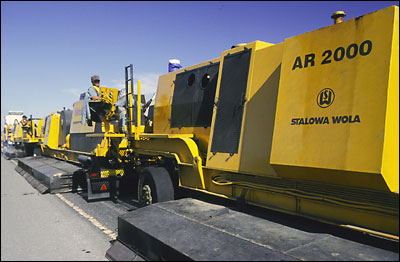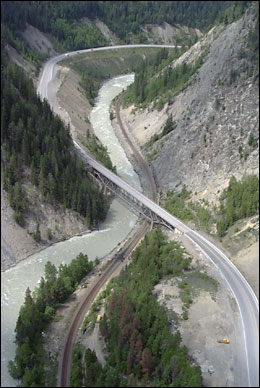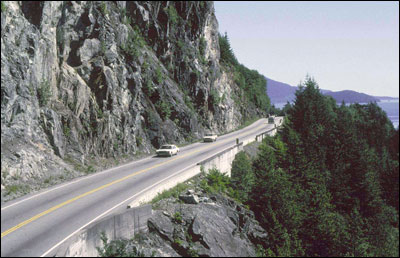 |
|
Resource Summary
BC Transportation Financing Authority — Consolidated Income Statement
Rapid Transit Project 2000 — Income Statement
Transportation Investment PlanIn February 2003, the government announced the first phase of a
multi-year Transportation Investment Plan. The Plan is set out in
detail in "Opening up BC: A transportation plan for British Columbia",
available online at: http://www.gov.bc.ca/bcgov/content/images/transportation_ The Plan is financed primarily from a 3.5 cents per litre motor fuel tax that was implemented on March 1, 2003. These taxes are dedicated through legislation to the BC Transportation Financing Authority. Additional funding of $200 million is expected from the proceeds of the BC Rail Partnership. The province will provide over $1.9 billion from 2003/04 to 2006/07 for investment in transportation infrastructure. The funds will be used to leverage cost-sharing and partnership arrangements with federal, regional and municipal governments and private sector partners to initiate projects totalling $6.5 billion. Key elements of the Plan are set out in the following section. Highway RehabilitationObjectives: To keep the provincial highway network safe and reliable, and to prevent deterioration from 2003/04 levels, when 76 per cent of highways and 80 per cent of bridges were in good condition. This is to be achieved through the resurfacing of approximately 7,500 kilometres of highway through 2006/07, and continued investment in seismic retrofitting and in safety improvements such as guardrail installation. Costs: Projected investment from 2004/05 through 2006/07 is $438 million. Benefits:
Risks: Flooding, slides and other natural events could affect the scheduling and completion of projects.
Highway CorridorsObjective: To improve performance of highway corridors through smaller projects such as passing lanes, 4-laning, left turn slots, and realignments. Costs: Projected investment from 2004/05 through 2006/07 is $278 million. Approximately $35 million of this will be provided by the federal government under the Strategic Highway Program and a further $34 million is anticipated from cost-sharing with developers and local governments. Benefits:
Risks: Flooding, slides and other natural events could affect the scheduling and completion of projects. Transportation Partnership ProgramObjective: To provide capital contributions to those public port and airport infrastructure investments that will result in significant, incremental economic benefit. The ministry has to date expressed support for projects that will see expansions to airports at Cranbrook and Prince George, and the development of a container handling facility at the Port of Prince Rupert. Costs: Projected expenditures from 2004/05 through 2006/07 are $37 million. Benefits:
Risks:
Heartlands RoadsObjectives: The ministry is dramatically increasing its investment in northern and rural roads. British Columbia's heartlands communities and resource industries rely on these critical lifelines to reach essential services, natural resources and world markets. Making these roads safer and more reliable will help revitalize the provincial economy and strengthen ties between B.C. communities. The northern and rural road network is deteriorating faster each year, making its renewal a top priority. Costs: Projected investment from 2004/05 through 2006/07 is $225 million. Benefits:
Risks: Flooding, slides and other natural events could affect the scheduling and completion of projects. Oil and Gas Exploration RoadsObjective: Improve the side road network, especially in the Peace River area, to strengthen the road base and reduce restrictions on road use in order to increase oil and gas exploration activity. Costs: Projected investment is $13 million in 2004/05, the final year of this 6-year program. Benefits:
Risks: Flooding, slides and other natural events could affect the scheduling and completion of projects. Border Crossing ProgramObjective: More than $24 billion in goods travel through B.C.'s borders each year, and the health of the provincial economy depends on these gateways. Delays cost cross-border carriers over $60 million a year, according to a 1998 survey of B.C. trucking companies, and the more stringent security measures in recent years have added to these delays. The provincial government's border crossing program will enhance the free flow of goods through B.C.'s busiest border crossings. Projects at the border or on highway approaches will use infrastructure improvements and investments in transportation technology to keep international trade moving and B.C.'s economy strong. Costs: The estimated total program cost is $242 million, which encompasses project expenditures beyond the three-year scope of this service plan. Of this, British Columbia is to provide $135.5 million, while the federal government is to contribute $102 million under the Strategic Highway Infrastructure Program and the Border Infrastructure Fund. Other partners are to contribute $4.5 million. Benefits:
Risks:
Weigh Scales Upgrade ProgramObjectives: Protect road integrity with greater efficiency and reduce congestion, delays and safety related problems at weigh scales. This will be accomplished by relocating and redesigning weigh scales, implementing joint facility operations at borders, and/or using new technologies with intelligent transportation systems to process truck traffic more efficiently. Costs: Projected expenditures from 2004/05 through 2006/07 are $15 million. Benefits:
Risks: Cost estimates are based on preliminary information. Okanagan Corridor ImprovementsObjective: To improve safety and capacity in the Okanagan corridor, beginning with the four-laning of Highway 97 north of Swan Lake and upgrades to key portions of Highway 1. Costs: Projected expenditures from 2004/05 through 2006/07 are $67 million, excluding the construction of a new Okanagan Lake Bridge. Benefits:
Risks: No material risks have been identified. Gateway ProgramObjectives: The ministry has begun development of a Gateway Program, a potential set of improvements to the regional road network that would significantly improve the movement of people, goods and services along and across the Fraser River. The Program would increase access to trade and industrial facilities, reduce travel times, improve neighbourhood livability and take a significant step toward completing the region's road network. Potential Gateway projects include: The South Fraser Perimeter Road Project — a new east-west route along the south side of the Fraser River from Port Kells in Surrey/Langley to Deltaport Way in South Delta, providing significantly improved access to industrial areas, travel time savings for residents, and a free-flow route for tourists accessing the ferries to Vancouver Island. The North Fraser Perimeter Road Project — localized operational, safety and capacity improvements to existing roads from the north end of the Queensborough Bridge in New Westminster to the north end of the proposed New Fraser River Crossing in Pitt Meadows/Maple Ridge. The project would include improved reliability over the Pitt River via a new fixed link. The Port Mann Bridge/Highway 1 Project — twinning the Port Mann Bridge as well as improving access and traffic flow along the region's primary trade corridor from approximately First Avenue in Vancouver to 200 Street in Langley. The Port Mann Bridge currently is the single-most congested area in the Province, with traffic queues for up to 16 hours a day. Costs, Benefits and Risks: The Ministry of Transportation is currently working with the Greater Vancouver Transportation Authority (GVTA) and municipalities to assess the existing highway network, review traffic forecasts and develop the scope of each potential project. Preliminary estimates suggest that the infrastructure investment would be in the range of $3 billion. Detailed consultation with local governments, communities and road users will begin in 2004. Major Capital ProjectsNisga'a HighwayObjective: The Nisga'a Highway Project is beginning year six of a seven-year investment program that involves upgrading the Nisga'a Highway from a gravel resource road to an all-weather, two-lane highway that meets a 70 kilometres per hour standard. The upgrade is now 70 per cent paved and complete, and the remaining segments are easy to construct in comparison to the completed work. The upgrade will better serve Nass Valley residents and resource industries in the area. Costs: The estimated total cost for the seven-year program is $52 million. Benefits:
Risks: This project has presented engineering and construction challenges due to the rugged terrain. However, few risks remain as the construction left on the Nisga'a Highway upgrade is straightforward gravel and paving work. Kicking Horse CanyonObjective: Upgrade the 26-kilometre section of the Trans-Canada Highway to a modern four-lane standard from the junction of Highway 95 at Golden to the western boundary of Yoho National Park. This mostly two-lane corridor, originally constructed throughout the 1950s, is an important route for tourism, resource development and inter-provincial trade. Costs: The estimated cost is $191 million for the first two phases.
Note: It is anticipated in the future there will be a third phase for upgrades from Golden to 5-Mile and 10-Mile to Yoho National Park when federal cost-sharing is secured. Improvements will likely be made over the longer term, rather than within the three-year scope of this service plan.
Benefits:
Risks:
Okanagan Lake BridgeObjectives: To construct a new five-lane bridge to replace the 45 year old bridge now at the end of its economic and useful life, and to reduce congestion in peak hours and through the summer. The project includes construction of a pair of one-way streets in downtown Kelowna to improve traffic flow, a truck climbing lane on the west side of Okanagan Lake, and two interchanges on the west side of the bridge. Costs: The bridge project is expected to cost approximately $100 million. In addition, improvements valued at approximately $20 million will be constructed on the west side of the bridge. The province is delivering the bridge project through a public-private partnership. Benefits:
Risks: Engineering challenges. However, the risks associated with the construction of floating bridges have been substantially reduced in recent years with the introduction of new flotation technologies. Sea-to-Sky HighwayObjectives: Implement critical safety and reliability upgrades to Highway 99 (the Sea-to-Sky Highway) and construct lane expansions along some sections of the highway between Horseshoe Bay and Whistler. The schedule requires these upgrades to be completed by the end of 2009. The work will be delivered by public-private partnerships. These upgrades are in addition to other improvements currently under construction between Culliton Creek and Cheakamus Canyon. Costs: The estimated construction cost is $600 million. Further information, including a Capital Project Plan on the Sea-to-Sky Highway Improvement Project, is available at http://www.seatoskyimprovements.ca/.
Benefits:
Risks:
Rapid Transit Project 2000Objective: The Millennium Line project, which is mostly complete and is running smoothly, included construction of the 21.6 kilometre Millennium Line extension to the SkyTrain rail transit system in the Lower Mainland, plus feasibility studies of two planned further extensions of SkyTrain.
Costs: The total cost of the Millennium Line is forecast to be $1.12 billion, which is lower than its approved budget of $1.17 billion. An operating lease with TransLink is in the final negotiation stage. Benefits:
Risks: Risks are related to one remaining section, from Commercial Station to Vancouver Community College, which faces standard construction and financial risks and is expected to be completed in early 2006. Fees and LicencesCoquihalla Highway TollsTolls are levied for vehicles using the Coquihalla Highway. Estimated annual revenue is approximately $47 million. Motor Carrier RegulationThe ministry is currently working towards the implementation of revisions to fees and licences administered by the Motor Carrier Commission and Branch. Current estimated annual revenue is approximately $700,000. Development ApprovalsDevelopment Approvals fees are charged for rural subdivision approvals. Estimated annual revenue is approximately $200,000. Progress to establish full cost recovery options for this program has been slower than anticipated and results will be delayed by one year. . |
|||||||||||||||||||||||||||||||||||||||||||||||||||||||||||||||||||||||||||||||||||||||||||||||||||||||||||||||||||||||||||||||||||||||||||||||||||||||||||||||||||||||||||||||||||||||||||||||||||||||||||||||||||||||||||||||||||||||||||||||||||||||||||||||||||||||||||||||||||||||||||||||
|
||||||||||||||||||||||||||||||||||||||||||||||||||||||||||||||||||||||||||||||||||||||||||||||||||||||||||||||||||||||||||||||||||||||||||||||||||||||||||||||||||||||||||||||||||||||||||||||||||||||||||||||||||||||||||||||||||||||||||||||||||||||||||||||||||||||||||||||||||||||||||||||||




